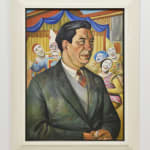




Leo Bensemann
980 x 780 x 35mm framed
Further images
The subject of this painting is Gregory Kane, noted as a close friend of Bensemann by his daughter Caroline Otto, who writes about an unfinished watercolour of Kane painted during the 1960s. Kane was also the sitter for several other portraits by Doris Lusk. A library archive entry states Kane was a Christchurch theatre producer and artist, characteristics which Bensemann appears to imbue into this work. The background of this painting as what looks to be a circus, with clown-like figures and the outline of a tent, may reference Kane’s position at the theatre and his influence on the Christchurch arts scene.
Otto also notes her father’s interest in the book The Thurber Carnival, a revue by James Thurber adapted from his stories, cartoons and casuals, nearly all of which originally appeared in the New Yorker. Bensemann was intrigued by Thurber’s interpretations of the absurd, in people and everyday life, and this influenced his own work. Bensemann’s portraits aimed to capture more than just the likeness of his sitters, but a whole personality, quirks and all.
Peter Simpson has reflected on the artist; ‘always something of an odd man out, Bensemann has proved hard to integrate into the accepted narrative of New Zealand art history and is much less well known than he deserves. However, the sheer quality of his output over more than fifty years is steadily extending his reputation as one of New Zealand's most distinctive artists.’
References:
1 Caroline Otto, Leo Bensemann: Portraits, Masks & Fantasy Figures, Nelson: Nikau Press, 2005, p.92
2 Peter Simpson, Fantastica: The World of Leo Bensemann, Auckland: Auckland University Press, 2011, p.VII
Provenance
Collection of the late Colette de Morand, London, UKExhibitions
Group Exhibition, Spring Catalogue 2024, 25 September - 19 October 2024, Gow Langsford Gallery, Auckland, New ZealandLiterature
Leo Bensemann, Gregory Kane, oil on board, 1962
PETER SIMPSON
The subject of this intriguing 1962 portrait by Leo Bensemann is Gregory Kane (1921-74), an actor, theatre producer, arts organiser and amateur painter well-known in Christchurch from the 1940s through to the 1970s. His main claim to fame was as founder of the Theatre Arts Guild, 1949-63, an alternative theatre group which performed classic plays from Sophocles to Tennessee Williams, including numerous Shakespeare productions (often outdoors); Kane was often either actor or producer, or both. Several Christchurch artists, including Doris Lusk and Leo Bensemann, did portraits of him that were exhibited in Group Shows – Lusk in 1954 (now in Christchurch Art Gallery) and 1969, Bensemann in 1962; the latter also did an unfinished watercolour portrait of Kane, now in the Macmillan Brown Library. Both Lusk and Bensemann highlighted the theatrical dimension of Kane’s identity, Bensemann through the lively assemblage of clownish performers cavorting in front of a curtained stage which serves as background to the figure.
Bensemann was 50 when he painted this portrait. His career dates from the early 1930s, when he moved to Christchurch from Nelson, and continued until his death in 1986. A full-time printer and publisher with The Caxton Press, 1938-78, Bensemann was necessarily a part-time artist for much of his life. The main outlet for his drawings, wood engravings and paintings was the annual Group Show; He first showed with The Group in 1938 and remained a central member until it disbanded in 1977. From 1940 onwards Bensemann designed and printed all the distinctive annual Group catalogues at Caxton Press. Late in life Bensemann held four solo exhibitions at Akaroa (1972), Christchurch (1979, 1981) and Wellington (1983).



